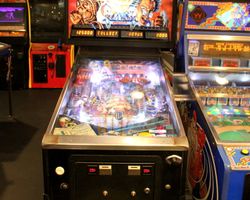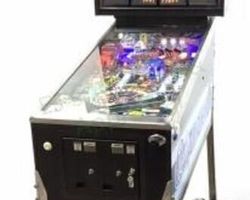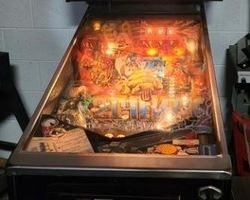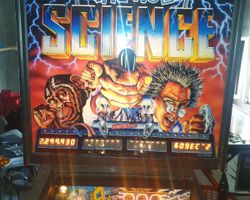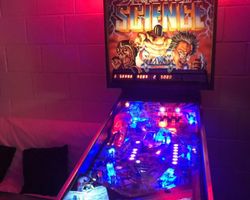Strange Science

Average Prices: USD $500 to $1,700
Produced: November, 1986
Production Run: 2,350 units
Machine Type: Solid State Electronic
MPU: Bally MPU A084-91786-AH06 (6803)
Players: 4
Design by: Dan Langlois
Art by: Greg Freres
Mechanics by: Greg Tastad
Software by: Howard Shere
"Strange Science" stands as a distinctive creation from Bally Manufacturing Co., a pinball machine that emerged in November 1986. This solid-state electronic (SS) game, designated Model 0E35, brought a playful take on the world of scientific experimentation to the arcade and home. The machine’s thematic inspiration drew from classic mad science tropes and laboratory antics, inviting players into a world of chemical reactions, particle acceleration, and chaotic discovery.
The design and production of "Strange Science" involved a dedicated team. Dan Langlois took on the role of game designer, crafting the foundational experience. The visual identity of the machine was shaped by artist Greg Freres, who rendered the vibrant and detailed playfield and backglass artwork. Bob Libbe composed the game's unique soundscape, while Howard Shere was responsible for the software that brought the rules and interactions to life. Mechanical elements were overseen by Greg Tastad. With a production run of 2,350 units, "Strange Science" represented a notable release for Bally in the mid-1980s, showcasing some technical advancements of the era. A curious detail from its development history is a whitewood version that featured an orange "Hold Bonus" insert, differing from the green used in the production models. This minor variation highlights the iterative process in pinball machine development.
Signature Features and Design
"Strange Science" is defined by a suite of inventive features that set it apart. Central to its identity is the "Atom Smasher," a unique mechanism that serves as a multi-ball lock and release system. This interactive toy is not merely a static target; it involves a kinetic effect where hitting a bottom ball can push a top ball onto a metal ramp, leading to the exhilarating initiation of multi-ball play, ranging from two to a full five balls.
Another defining element is the "anti-gravity up-loop," a vertical plastic ramp that sends the ball through a full 180-degree loop. This visually striking shot is a testament to the designers' creativity in manipulating ball movement in the vertical plane. The machine also features a "particle-separator ramp," contributing to the scientific laboratory theme. Beyond these major mechanical features, "Strange Science" was one of the earliest pinball machines to incorporate a neon light, positioned as a topper on the backbox, adding a distinct visual flair and a high-voltage aesthetic that immediately captures attention. The game also utilized unique plasma displays for text, a technology distinct from the typical alphanumeric displays of its time. While offering a novel look, the limited capabilities of these early plasma displays sometimes rendered letters challenging to distinguish or appearing more like numbers, adding to the game's quirky charm.
Playfield and Mechanics
The playfield layout of "Strange Science" is an intricate laboratory of shots and interactive elements. Dominated by its scientific theme, the layout features three flippers, three pop bumpers, and three distinct ramps that guide the ball through various experiments. The central area of the playfield is anchored by the "anti-gravity up-loop" and the "Atom Smasher" assembly. Shots into the Atom Smasher are crucial for building towards the game’s signature 5-ball multi-ball. A "kick-out hole" provides additional targets, and a player-controlled kickback in the left outlane offers a strategic defensive option, preventing immediate drains and extending ball time for skilled players.
The flow of the playfield is designed to encourage exploration and precision. Shots to the ramps, including the "particle-separator," are often challenging but reward careful aim. The design philosophy aims to immerse the player in a dynamic scientific environment where every successful shot feels like a controlled experiment. Artwork by Greg Freres blankets the playfield with imagery of beakers, test tubes, electrical arcs, and strange scientific apparatus, reinforcing the "Pinball Chemistry" theme. The color palette is vibrant, utilizing greens, oranges, and purples that glow under the playfield lighting. The 6803 motherboard, which powers the machine, supports a dual-phase AC lamp system, allowing for up to 80 bulbs to create dynamic and responsive lighting effects that highlight active shots and modes, contributing to the overall high-voltage aesthetic. The cabinet artwork, while functional, tends to be more basic in design compared to the intricate playfield and backglass, which often receives acclaim.
Gameplay Dynamics
"Strange Science" presents a gameplay experience that balances intricate mechanics with demanding shot accuracy. The core progression revolves around activating and maximizing the potential of its central features. The 5-ball multi-ball is a primary objective, initiated by loading balls into the Atom Smasher. Once activated, multi-ball provides a chaotic and high-scoring opportunity, often described as a pivotal rush. Beyond multi-ball, the game offers various objectives that build score and unlock features, though some players found the rule set to be less intuitive than in other machines of the era, potentially obscuring deeper strategies without a clear understanding of the objectives.
The scoring system, while functional, has been noted by some for a perceived imbalance, with multi-ball often being the disproportionate path to high scores compared to other successful shots. The "power saver" mechanism, which kicks the ball back into an in-lane, provides a moment of reprieve and adds a layer of strategy for ball control. Players also have access to extra buttons for lane changing and activating the ball saver/kickback, providing more direct control over the ball's trajectory and extending play. Despite its depth, the game can be challenging, with quick drains down the middle or from certain center shots. Achieving the anti-gravity ramp shot consistently requires precise flipper work. The "Turbo Cheap Squeak" sound system, capable of playing back multiple sounds simultaneously, adds to the frantic energy, featuring synthesized effects and sometimes peculiar laughs that contribute to the game's distinctive atmosphere.
Reception and Legacy
"Strange Science" generally garners a mixed to positive reception within the pinball community, often considered a machine that truly shines when meticulously maintained and properly set up. Its strengths are frequently highlighted by its captivating playfield artwork, which many describe as vibrant and compelling. The neon topper is consistently praised as a unique and visually impactful element, adding a significant "wow factor." The sheer excitement of the 5-ball multi-ball, launched from the kinetic "Atom Smasher," is frequently cited as a major highlight, delivering a memorable and exhilarating experience. The challenging nature of its shots and the inclusion of extra buttons for control are also appreciated by players who seek a demanding yet rewarding game.
However, "Strange Science" also has its recognized weaknesses. A common point of feedback revolves around the strength of the flippers, characteristic of Bally machines from this era. Many players find that the original flippers are too "limp" to consistently make crucial shots, particularly to the center ramp and Atom Smasher, without significant rebuilding or modification. This issue can lead to frustration and quick drains, causing some to label it a "drain monster" if not properly maintained. The game's ruleset has also been a point of contention, with some finding it difficult to understand or perceive a clear progression, leading to a perception that not much is happening beyond the multi-ball. Additionally, while the sound package has its proponents for fitting the theme, others find it somewhat repetitive or the speech occasionally grating. Despite these criticisms, "Strange Science" holds a respected place in pinball history. It is often seen as a significant stepping stone in the evolution of solid-state games, particularly for its pioneering use of neon lighting and its ambitious multi-ball mechanics. Its unique blend of challenging gameplay, quirky theme, and innovative features ensures its continued discussion and appreciation among enthusiasts.
Sponsored Links
 Ebay Listings
Ebay Listings
 Auction Results
Auction Results
| Cost | Location | Date |
|---|---|---|
| USD $2,500 |  Michigan, United States Michigan, United States |
14 September, 2025 |
| USD $2,500 |  Missouri, United States Missouri, United States |
23 August, 2025 |
| USD $1,600 |  Arizona, United States Arizona, United States |
02 May, 2025 |
| USD $1,950 |  California, United States California, United States |
20 August, 2024 |
| USD $2,100 |  Maryland, United States Maryland, United States |
06 June, 2024 |
| USD $1,040 |  New York, United States New York, United States |
04 November, 2023 |
| EUR €2,110 |  Hessen, Germany Hessen, Germany |
02 June, 2023 |
| USD $4,000 |  Florida, United States Florida, United States |
12 June, 2022 |
| USD $2,450 |  Georgia, United States Georgia, United States |
21 October, 2021 |
| USD $2,500 |  New York, United States New York, United States |
09 August, 2021 |


Private Policy · Search Website · Contact Us
As an eBay Partner, we may earn a commission from qualifying purchases made through links on this site, at no additional cost to you.
All trademarks and copyrighted materials remain property of their respective owners. All other content copyright 2007 - 2025 Pinpedia.

